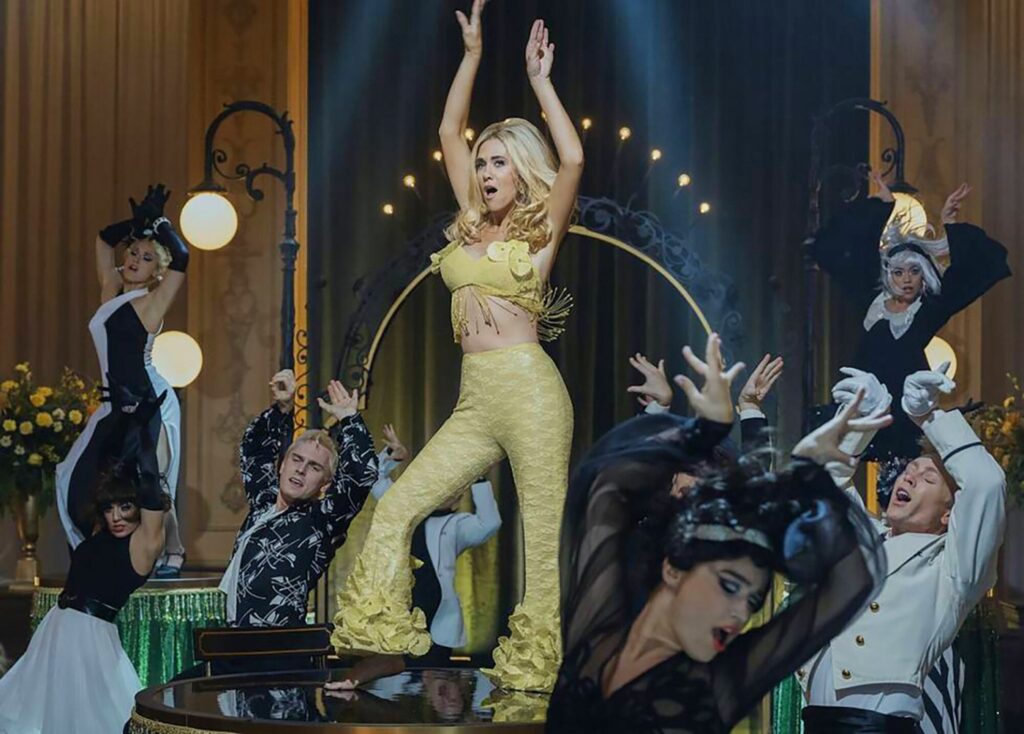
The highly anticipated second season of “Palm Royale” premiered this week on Apple TV, showcasing a vibrant blend of humor and vintage fashion that plays a pivotal role in its storytelling. In the opening scene, actress Kristen Wiig steps out of a vintage Rolls-Royce, adorned in a striking yellow fringed hat, gold platform sandals, and bell-bottomed trousers. This eye-catching ensemble sets the tone for a season where costumes are not just accessories but integral to character development and narrative depth.
The first season of “Palm Royale” captivated audiences with its star-studded ensemble, including legends such as Carol Burnett and Allison Janney, alongside high production values and the quirky grasshopper cocktail. Set in 1969 Palm Beach, Wiig’s character, Maxine, strives to infiltrate elite society, navigating a world filled with humor and style. This season, the costumes designed by Emmy-winning Alix Friedberg are once again at the forefront, with her team coordinating thousands of looks that reflect the characters’ glamorous lifestyles.
Friedberg reveals that 50-60% of the costumes are original vintage pieces, meticulously sourced to capture the essence of the era. “The looks are so iconic. Sometimes Kristen will walk in in something, and it brings tears to my eyes,” noted Kaia Gerber, who plays Mitzi, reflecting on the emotional impact of the designs.
Costumes Reflect Character and Theme
The creative process behind the costumes extends beyond mere shopping. When original vintage pieces are unavailable, Friedberg’s team constructs outfits, sometimes creating duplicates for continuity in scenes that require multiple changes. Her collection includes stunning original designs by renowned fashion houses such as Oscar de la Renta and Bill Blass. “There’s a dress that Allison Janney‘s character, Evelyn, wears that’s an original Halston, and it’s so stunning on her,” Friedberg explained.
Janney praised Friedberg’s expertise, calling her “brilliant” and highlighting how the costumes enhance her character’s presence. “All of them just make me feel divine,” Janney remarked, emphasizing the artistry involved in the hair and makeup that complement the outfits.
The comedic aspect of the show is further elevated by the costumes. Friedberg pointed out that Evelyn’s deadpan delivery becomes even funnier when paired with her extravagant outfits. “The absurdity comes out really in how these women present themselves,” she shared, illustrating how humor can be woven into the fabric of the characters’ wardrobes.
Burnett echoed this sentiment, describing costume fittings as invaluable in shaping her character, the scheming Norma. Initially, Norma’s signature turban was a practical choice for efficiency in hair and makeup, but it quickly became a defining feature of her persona. “The first time she put it on, we were both like, ‘Oh, that’s really so fabulous,’” Friedberg recalled, noting how the turban influenced the design of Norma’s dresses.
Empowerment Through Fashion
This season also explores themes of female empowerment through fashion. Friedberg noted that Evelyn’s increased use of pants in her wardrobe marked a significant statement for the era. “Back then that was a real power move,” she explained, highlighting the evolution of women’s fashion during that time.
Bibb emphasized the transformation of her character, Dinah, from a trophy wife to a woman of independence. Drawing inspiration from Sharon Stone in “Casino,” Bibb’s character embraces modernity with tailored pantsuits, symbolizing her personal growth.
The costumes also reflect the contrasting experiences of male characters. Josh Lucas, who plays Douglas, suggested a narrative where his character has always been dressed by women. As he faces disappointments this season, his wardrobe—comprising just a few worn Hawaiian shirts—mirrors his emotional state. Friedberg noted that Douglas is unique in the series for repeating outfits, which become increasingly threadbare as the story progresses.
Gerber highlighted the significant makeover her character undergoes this season, paralleling her journey toward empowerment. “It was so fun to be able to be wearing these expensive gowns and jewelry,” she said, emphasizing how her character’s outer transformation reflects her inner growth.
Ultimately, the costumes in “Palm Royale” serve as more than just eye candy; they enrich the narrative and deepen the audience’s understanding of each character. Friedberg pointed out a dress worn by Maxine, an original Oscar de la Renta piece, which subtly signals her rise to power. “It’s time for her to rule,” Friedberg stated, capturing the essence of the season’s themes.
As “Palm Royale” continues to unfold, the interplay of fashion and storytelling promises to engage audiences, making the second season a rich tapestry of humor, history, and empowerment.






